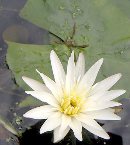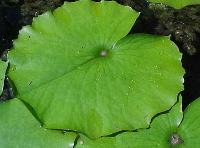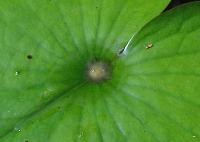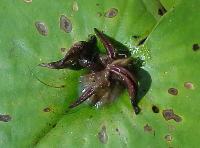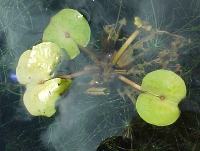In waterlilies there are several ways these little new plants are produced: in some tropical day bloomers from the pads, in some hardies and a very few tropical night bloomers from spent flowers.
Only one tropical day blooming species, N. micrantha from Africa, has this characteristic. It ranges from white through medium blue and is somewhere in the breeding of all viviparous cultivars.
|
N. micrantha itself, especially the white form, is so strongly viviparous that the vivips make vivips which make vivips, all while attached to the parent, but it is hard to keep going. Hybrids can be strongly or weakly viviparous, depending on breeding, growing conditions and time of year. Certain cultivars will only vivip in fall. There are several ways to encourage the development of vivips from nubs. One is to slightly wound the stem, as happens in nature to older pads from weather events or caterpillar attack. Another is to remove the parent pad from the plant with a few inches of stem and float it upside down. Once leaves have formed, baby vivips can be planted, bagged, "bricked" or simply left to float where eventually the developing tuber will cause the plant to sink to the bottom and become established. Bagged in ziplocks full of water and floated in a sunny pond, babies will actually mature somewhat until needed. "Bricking" is a term for anchoring babies under the edges of a heavy object to encourage the development of floating leaves and roots. The best method that we know of for getting viviparous plants
going has been developed by Sean Stevens - |
Tropical Day Blooming Viviparous Cultivars 'August Koch' 'Bagdad' 'Blink' 'Carla's Sonshine' 'Crystal' 'Daubenyana' 'Florida Star' 'Innocence' 'Islamorada' 'Josephine' 'Key Largo' 'Lindsey Woods' 'Mme. Ganna Walska' 'Margaret Mary' 'Mrs. Martin E. Randig' 'Mrs. Robert Sawyer' 'Nora' 'Panama-Pacific' 'Patricia' 'Paul Stetson' 'Peach Blow' 'Pink Platter' 'Pink Ruby' 'Queen of Siam' 'Ruby' 'Sarah Ann' 'Shirley Bryne' 'Teri Dunn' 'Tina' 'Vanilla Sky' |
|
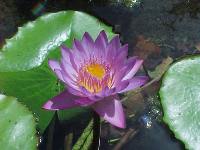 N. 'Panama Pacific' |
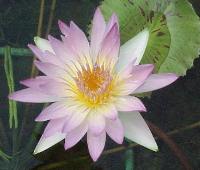 N. 'Peach Blow' |
|
|
|
||
|
|
||
 |
 |
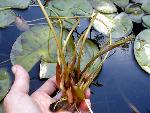 |
|
|
||
| As the flower fades, the small leaves may begin to unroll and sometimes roots will begin to form. Leave the plant attached to the flower stem until some roots and leaves are visible, and then put the plant in fertilized soil, placing it in a sunny, shallow spot in the pond. Sometimes the new plant develops, sometimes not...but it is worth the try. Rich Sacher, New Orleans, Louisiana | ||
|
Viviparous Cultivars 'Colonel A.J. Welch' 'Georgia Peach' 'Perry's Viviparous Pink' 'Phoebus' |
Vivips From Flowers |
Tropical Night Blooming Species N. prolifera |
